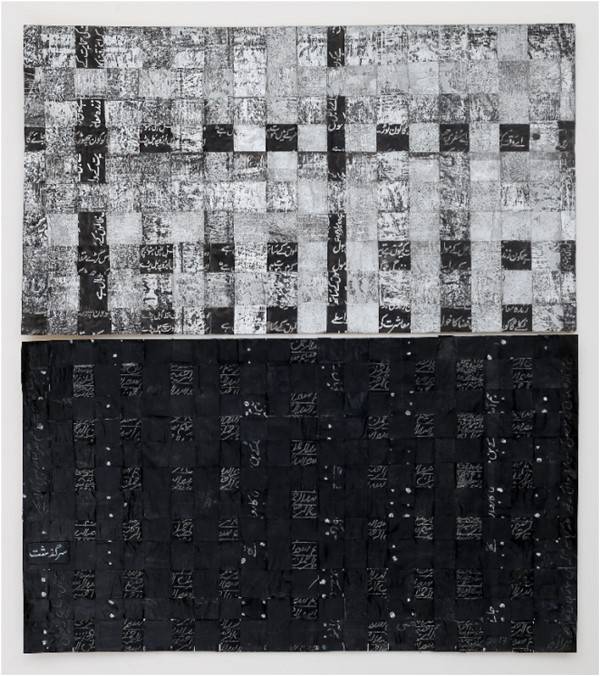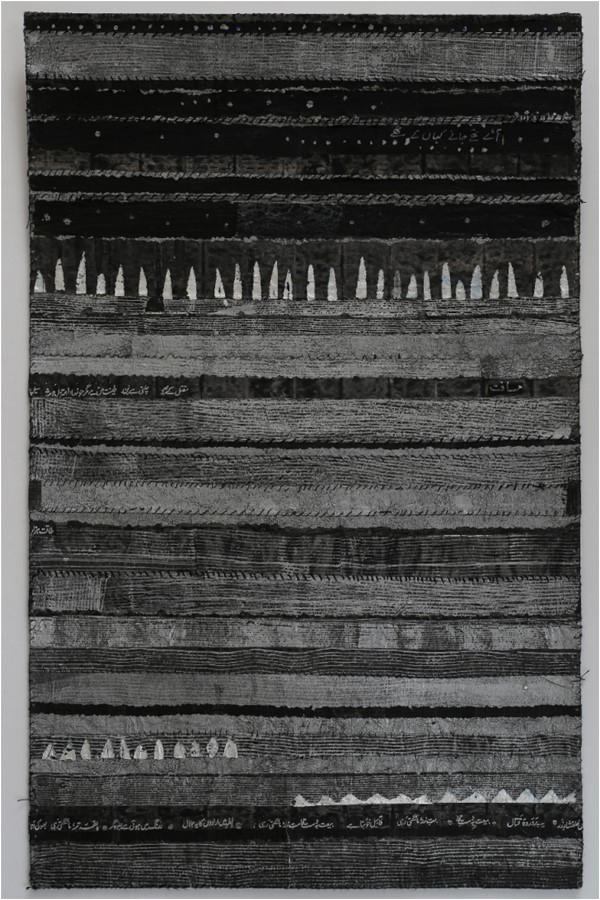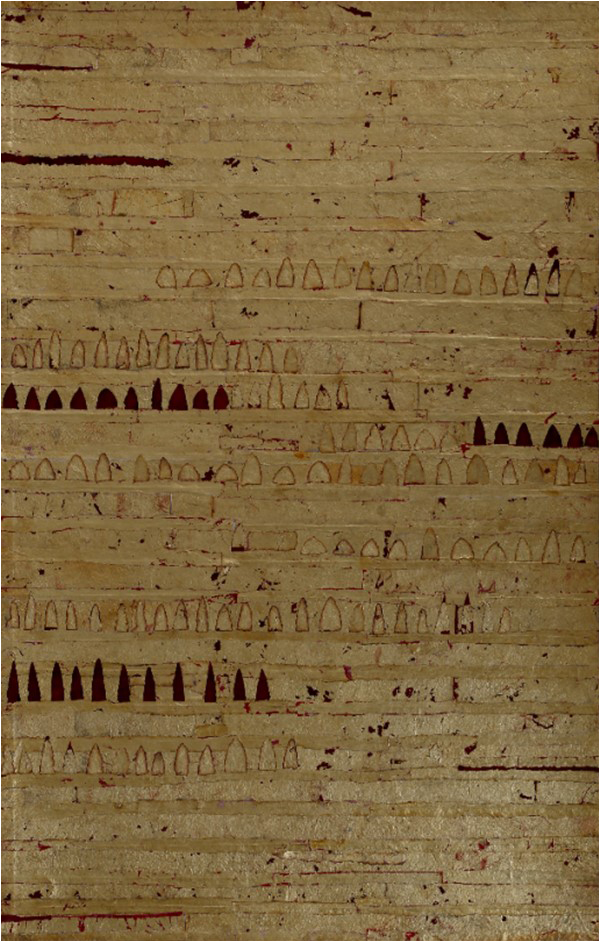
So different was the world MeherAfroz left in 1971 that it was as though a marine creature had washed up on Karachi’s shore. Away from Lucknow’s tehzeeb and spittoons, in a dusty Karachi without an art school, she is far, far from home. And how lucky are we.
Unlike the exhibitionism of some artists of today, Meher has been toiling quietly in her studio, experimenting and building on transactions that she began with us four decades ago. Over the years, her paintings have moved to figureless weathered surfaces that prevent easy interpretations. It’s a weathered ribbon that’s coiled through print, canvas, paper and metal. That’s why every show feels like a continuation of another conversation she’s had with us. In “AapBeeti” her current show at Karachi’s Chawkandi art gallery, she’s marked that journey for us – an observer and commentator of our lives and times.

The Quranic symbol “hu” that we saw in “Intimacy”, her Koel gallery group show back in 2013, is here: she repeatedly renders it till its curvy form melds into a cloud of bubbles in graphite. The pops of language from the 2016 show “The 70’s: the Radioactive decade” at the Amin Gulgee gallery: tactile, from another material so they have weight and presence. On paper and canvas, one word floats on an entire surface—Bayniyaz. On another, safar (journey). The words don’t seem didactic or preachy, but more like seeds.
Writer Saquib Hanif, a big fan of the artist, put it best, saying Meher continues “to cast the magic of muted notes.” Even the show itself is not the place where you would find selfies or skinny jeans, but an older, quieter audience. These are Meher’s fans. The show is mostly monochromes, moving into silver and metallic. It is a palette she has mastered. Grids, sliced, half darkness and light. She has stitched them like mended leather, painstakingly joining each square like a shoe maker. Graceful intermittences of text form a dark grid, a manuscript or a map.“I’ve worked really hard on this show”, she says. But then she’s always worked hard. Niilofur Farrukh, in her book Pioneering Perspectives, describes Meher’s mission “to layer, scratch, emboss acrylic pigment, until the surface coalesces with detail, to form (an independent) pictorial language.” On paper there are gentle renderings that travel across the surface like smoke through the air. The metallic works are heavier, linear and muscular. In the gallery space the pieces interact with one another beautifully.
The paintings travelled from the artist’s home studio frighteningly close to the show’s opening: “You know how Meher is,” Zohra Hussein, Chawkandi gallery’s director says, “she’s just never satisfied.” And it’s an uncanny ability to create layered, scruffy surfaces that maintain a precision and control.This paradox exists in the contemporary timelessness of the pieces, scrawled with Urdu poetry. Only Meher can manage this blend.There’s an heirloomlike quality, and its unsurprising since Meher, with her silver braid and pristine Urdu, is an inheritor of another way of life and thinking.

Recipient of the President’s Pride of Performance in 2014, Meher is one of the few artists to be successful both as printmaker and a painter: the two practices overlapping and informing each other. The show’s poster is a shimmering gold, with jagged-y red triangles poking through like portals. In Meher’s experienced hand, the gold looks rich – not precious or ostentatious. It explores the futile pursuit for perfection.
Her art practice has enriched Pakistan, as have the printmaking departments of two major art institutions in the city. And she’s guided generations of brushes, once telling a young artist to not use the colours in a tube but instead “dil kay colours” (colours from the heart). Standing in front of her blue paintings, she challenges you to name the shade: part lapis, older sister of sapphire. A wonderfully deep velvet you can swim in. Sadly there were only two blue pieces in this show.
In several of the works, Hilal Naqvi’s verses flitter in turquoise, silver or red. Alluding to the importance of the hand, they are a powerful metaphor from the tragedy of Karbala, the event that shines in Meher’s universe, colouring everything she does. It gives her work a heart-breaking sensitivity, and a cry no one is willing to make.
We are so much richer and fortunate that she made that journey in 1971: leaving her natural habitat to do her quiet explorations in our unruly ecology.
Unlike the exhibitionism of some artists of today, Meher has been toiling quietly in her studio, experimenting and building on transactions that she began with us four decades ago. Over the years, her paintings have moved to figureless weathered surfaces that prevent easy interpretations. It’s a weathered ribbon that’s coiled through print, canvas, paper and metal. That’s why every show feels like a continuation of another conversation she’s had with us. In “AapBeeti” her current show at Karachi’s Chawkandi art gallery, she’s marked that journey for us – an observer and commentator of our lives and times.

The Quranic symbol “hu” that we saw in “Intimacy”, her Koel gallery group show back in 2013, is here: she repeatedly renders it till its curvy form melds into a cloud of bubbles in graphite. The pops of language from the 2016 show “The 70’s: the Radioactive decade” at the Amin Gulgee gallery: tactile, from another material so they have weight and presence. On paper and canvas, one word floats on an entire surface—Bayniyaz. On another, safar (journey). The words don’t seem didactic or preachy, but more like seeds.
Writer Saquib Hanif, a big fan of the artist, put it best, saying Meher continues “to cast the magic of muted notes.” Even the show itself is not the place where you would find selfies or skinny jeans, but an older, quieter audience. These are Meher’s fans. The show is mostly monochromes, moving into silver and metallic. It is a palette she has mastered. Grids, sliced, half darkness and light. She has stitched them like mended leather, painstakingly joining each square like a shoe maker. Graceful intermittences of text form a dark grid, a manuscript or a map.“I’ve worked really hard on this show”, she says. But then she’s always worked hard. Niilofur Farrukh, in her book Pioneering Perspectives, describes Meher’s mission “to layer, scratch, emboss acrylic pigment, until the surface coalesces with detail, to form (an independent) pictorial language.” On paper there are gentle renderings that travel across the surface like smoke through the air. The metallic works are heavier, linear and muscular. In the gallery space the pieces interact with one another beautifully.
The paintings travelled from the artist’s home studio frighteningly close to the show’s opening: “You know how Meher is,” Zohra Hussein, Chawkandi gallery’s director says, “she’s just never satisfied.” And it’s an uncanny ability to create layered, scruffy surfaces that maintain a precision and control.This paradox exists in the contemporary timelessness of the pieces, scrawled with Urdu poetry. Only Meher can manage this blend.There’s an heirloomlike quality, and its unsurprising since Meher, with her silver braid and pristine Urdu, is an inheritor of another way of life and thinking.

Recipient of the President’s Pride of Performance in 2014, Meher is one of the few artists to be successful both as printmaker and a painter: the two practices overlapping and informing each other. The show’s poster is a shimmering gold, with jagged-y red triangles poking through like portals. In Meher’s experienced hand, the gold looks rich – not precious or ostentatious. It explores the futile pursuit for perfection.
Her art practice has enriched Pakistan, as have the printmaking departments of two major art institutions in the city. And she’s guided generations of brushes, once telling a young artist to not use the colours in a tube but instead “dil kay colours” (colours from the heart). Standing in front of her blue paintings, she challenges you to name the shade: part lapis, older sister of sapphire. A wonderfully deep velvet you can swim in. Sadly there were only two blue pieces in this show.
Only Meher can manage this blend.There’s an heirloomlike quality, and it's unsurprising since Meher, with her silver braid and pristine Urdu, is an inheritor of another way of life and thinking
In several of the works, Hilal Naqvi’s verses flitter in turquoise, silver or red. Alluding to the importance of the hand, they are a powerful metaphor from the tragedy of Karbala, the event that shines in Meher’s universe, colouring everything she does. It gives her work a heart-breaking sensitivity, and a cry no one is willing to make.
We are so much richer and fortunate that she made that journey in 1971: leaving her natural habitat to do her quiet explorations in our unruly ecology.

